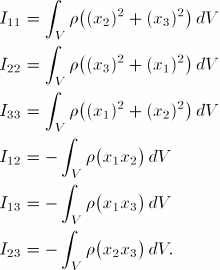
Products: Abaqus/Standard Abaqus/Explicit Abaqus/CAE

Rotary inertia elements:
allow rotary inertia to be included at a node;
are associated with the three rotational degrees of freedom at a node; and
can be paired with a MASS element (“Point masses,” Section 30.1.1) to define the mass and inertia properties of a rigid body directly (“Rigid body definition,” Section 2.4.1).

The ROTARYI element allows rotary inertia to be included at a node. The node is assumed to be the center of mass of the body so that only second moments of inertia are required. If the node is part of a rigid body, the offset between the node and the center of mass of the rigid body is accounted for. All six components of the rotary inertia tensor—![]() ,
, ![]() ,
, ![]() ,
, ![]() ,
, ![]() , and
, and ![]() —about the global coordinate system are defined as follows:
—about the global coordinate system are defined as follows:

You specify the moments of inertia, which should be given in units of ML2. You must associate these moments of inertia with a region of your model.
Optionally, you can refer to a local orientation (“Orientations,” Section 2.2.5) that defines the directions of the local axes for which the rotary inertia values are being given. If you do not specify a local orientation and the rotary inertia element is defined within a part or a part instance (see “Defining an assembly,” Section 2.10.1), the components of the inertia tensor must be given with respect to the local part axes. If you do not specify a local orientation and the rotary inertia element is not defined within a part or a part instance, the components of the inertia tensor must be given with respect to the global axes.
| Input File Usage: | *ROTARY INERTIA, ELSET=name, ORIENTATION=name |
where the ELSET parameter refers to a set of ROTARYI elements. |
| Abaqus/CAE Usage: | Property or Interaction module: Special |

In Abaqus/Standard you can define mass proportional damping for direct-integration dynamic analysis or composite damping for modal dynamic analysis. Although both damping definitions can be specified for a set of ROTARYI elements, only the damping that is relevant to the particular dynamic analysis procedure will be used.
In Abaqus/Explicit mass proportional damping can be defined for ROTARYI elements.
You can define inertia proportional damping for ROTARYI elements in direct-integration dynamic analysis or explicit dynamic analysis. See “Material damping,” Section 26.1.1, for details.
| Input File Usage: | *ROTARY INERTIA, ALPHA= |
| Abaqus/CAE Usage: | Property or Interaction module: Special |
You can define the fraction of critical damping to be used with the ROTARYI elements when calculating composite damping factors for the modes when used in modal dynamic analysis. See “Material damping,” Section 26.1.1, for details.
| Input File Usage: | *ROTARY INERTIA, COMPOSITE= |
| Abaqus/CAE Usage: | Property or Interaction module: Special |

In geometrically nonlinear analysis in Abaqus/Standard, rigid body rotary inertia contributes some unsymmetric terms to the system matrix when the motion is in three dimensions and the rotary inertia is not the same about all three axes. Therefore, in cases when the rotary inertia effects are significant, the solution may converge faster if you use the unsymmetric matrix storage and solution scheme for the step (“Defining an analysis,” Section 6.1.2).